One of my favorite things about working in a customer support role is the larger support community. When you combine people doing similar work with a job function that emphasizes being helpful and friendly, the result is a great group of colleagues to collaborate with and learn from.
A strong example of this was our inaugural Support Roundtable last year where support pros from a diverse set of web apps lent time and expertise to reveal best practices on three topics.
After a positive response, we decided to conduct a second support roundtable via email interviews. I'm very excited today to share the results.
The Panelists

Carolyn Kopprasch is the Chief Happiness Officer at Buffer, a social media tool to schedule and share content across multiple channels.

Grace Antonio is the Support Manager at FreshBooks, cloud-based accounting software for small, client-service businesses.

Justin Seymour is a Customer Champion at Help Scout, web-based help desk software designed for a great customer experience.

Brian Cervino is the Support Lead at Trello, a flexible web-based project management tool.

Micah Bennett—the moderator of the roundtable and author of this post—is the Support Lead at Zapier, an app automation and integration tool.
The Questions
1. What tools do you use to help serve your customers?
Carolyn Kopprasch, Buffer
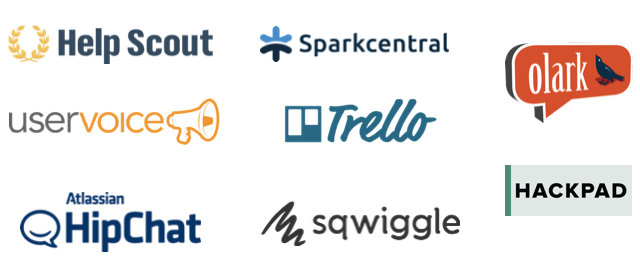
Ah, the bones of the operation! On the front lines, we use Help Scout for email, Sparkcentral for Twitter, Olark for live chat, and UserVoice for feature requests. Behind the scenes, we use Trello to organize bugs and signals, and HipChat, Sqwiggle and Hackpad to stay up to date on what we need to know so we can best serve our customers. :)
Grace Antonio, FreshBooks

FreshBooks uses RT: Request Tracker to reply to and keep track of email support. We like it because it’s open source, customizable and allow for many users so we can have any FreshBooker log in at any time to help out. For live chat, we use LiveChat Inc. We only recently implemented live chat as a support portal and chose this one because it offers great context when chatting. You can see where the user is from, what web pages they have navigated to and what pages they currently are on.
To keep track of feature requests and also to record all support inquires and what they were about, we created our own software in-house called Supporter that is integrated into RT, LiveChat and our phones. After every email, call or chat, we use Supporter to track the category, feature request and any comments about the call. We can easily add new categories when we need to and can run database queries about what users ask about and when.
We also use Confluence as an internal tool for our Support Team. On our wiki, you can find tons of information about answers to common questions, troubleshooting, processes or for fun stuff like signing up for the next team get-together at a soccer game.
Justin Seymour, Help Scout

Help Scout, of course! But aside from our own product, we're not reliant on any particular tool or service to get the job done. Don't get me wrong, there are tons of truly wonderful tools out there that'll save you time, or increase efficiency, or help you manage something that probably doesn't need managing, but they're not for everyone.
The most important asset you bring to each and every customer conversation is your knowledge. Of course, your game face and a steadfast will-to-do-good are both required.
Brian Cervino, Trello
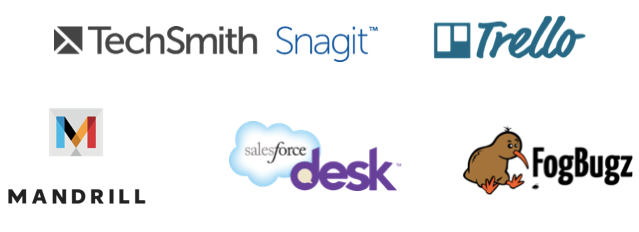
The main tools that I use to serve our Trello customers are FogBugz for case management, Desk for help documentation, Mandrill as our email client, Snagit for screenshots, and of course Trello for providing in-app support. I actually recently wrote a blog post about the Trello support toolbox.
Micah Bennett, Zapier

For handling support email we use Help Scout, and for measuring user satisfaction we use Hively. Outside the customer's view, we use Zapier to help funnel social mentions into Help Scout so we can use it as the one inbox to focus on, and we also use Trello for tracking feature/app requests and for our own projects as a support team.
Also, since everyone on the Zapier team does support, it has led to some great internal tools for support as well. From a killer custom Chrome extension to surface all the customer info we could want in Help Scout, to internal monitoring tools for better understanding when a specific API is having problems, Zapier support is far easier as a result of everyone feeling the need for those tools.
2. How are users able to contact you? Why those touch points?
Carolyn Kopprasch, Buffer
Wherever we are! :) We have the most communication through email, Twitter, and live chat, but we also hear from customer on Facebook and Google+, through the Google Play store for Android, and the App Store for iPhone. Also, over video calls and in person! Any time we talk to customers, they share awesome ideas about ways we can improve to better serve their needs. No one knows their needs as well as they do. Especially not us! Not by a long-shot. :) We spend way too much time in our own product to be able to see things with fresh eyes. So anytime we have a chance to listen, we try to take it.
Grace Antonio, FreshBooks
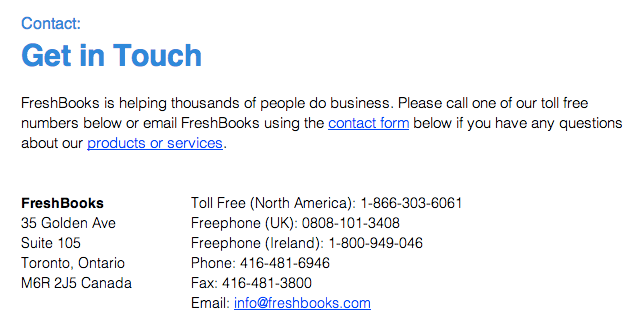
Users are able to contact FreshBooks through email, phone and live chat. We think it’s super important to offer phone support because it’s the most human form of communication. We get the chance to speak with all different kinds of small business owners (a very inspiring bunch), build rapport and ask them about their business—this allows us to give a more personalized and accurate answer. Also, it’s an opportunity for us to wow them with our level of support because at FreshBooks, there are no phone trees or being put on hold before getting to speak with real person. Emails have the potential for a lot of back and forth before fixing an issue, whereas on the phone, it can be sorted on the spot. It’s also nice to give our users the option of how they prefer to contact us instead of forcing them to use only email or contact forms.
We just recently added live chat to our arsenal. It’s actually still in beta right now and turned on for only a small percentage of accounts as we test it out. We decided to add this in after sending a Customer Service Survey to over 10,000 users a few months ago. Overwhelmingly, they told us that they would like to see live chat added as a way to contact support, so we added it.
Justin Seymour, Help Scout
Email is our number one touchpoint because we offer an email-based product, and email is just a natural communication channel these days. In 1832 it was the telegraph, and in 2014, it's email. Maybe in 2065 we'll see life sized holograms projected from the Apple logo on your MacBook.
For now, email is a simple, effective communication channel, and that's what matters most. To be fair, live chat is gaining real traction on the preferred channel front, but while we used to offer chat support, it's not something we're keen on providing. Every so often someone will ask why we don't provide live chat support, and the answer is always the same: what’s right for some isn’t right for all, and we honestly don’t feel this channel is a win for our support team or our customers.
Nick Fuller over at GoDaddy has a really interesting take:
After reviewing customer behavior and satisfaction scores we decided we could better serve people in ways they were telling us work better for them.
Customers love the "real time" support experience. Email is not instantaneous and in fact many in the industry are putting an end to their email service as well because fewer than half of tech customers believe their problem can be solved by email—it’s sort of going the way of the cassette tape.
I certainly won't argue the fact that folks gaggle over a real time support experience, nor will I question the longevity of email, but I'm just not on board with the instant gratification thing. Why does support have to be instantaneous? Instant gratification may be what people say they want, but that doesn’t mean it's what they actually need.
And what about the people on the other side of the chat window? Our team structures their own working day, hour by hour. We don't hold anyone to any required screen time, ever. Daily freedom to work and to live as we see fit is a huge part of who we are. I cringe at the thought of having to man a chat window all day, or in a pre-scheduled shift, but that’s just my opinion.
Maybe in 2065 we'll see life sized holograms projected from the Apple logo on your MacBook.
Justin Seymour, Help Scout
One insidious problem with live chat is that it creates a pressure laden, "do or die" support environment. It feels like you're on a timed speed run, and when support starts becoming a race, bad things happen. Companies with top-tier email support will get back to you in less than 24 hours and often times within the hour; all perfectly reasonable expectations.
As an added benefit to email support, there’s no rush and no stress on the support person, who can make sure that the response they provide is comprehensive and double-checked for accuracy.
You have to decide which channels allow you to provide the best support possible. We made a call that connecting with customers over email is just a much better experience all-around.
Brian Cervino, Trello
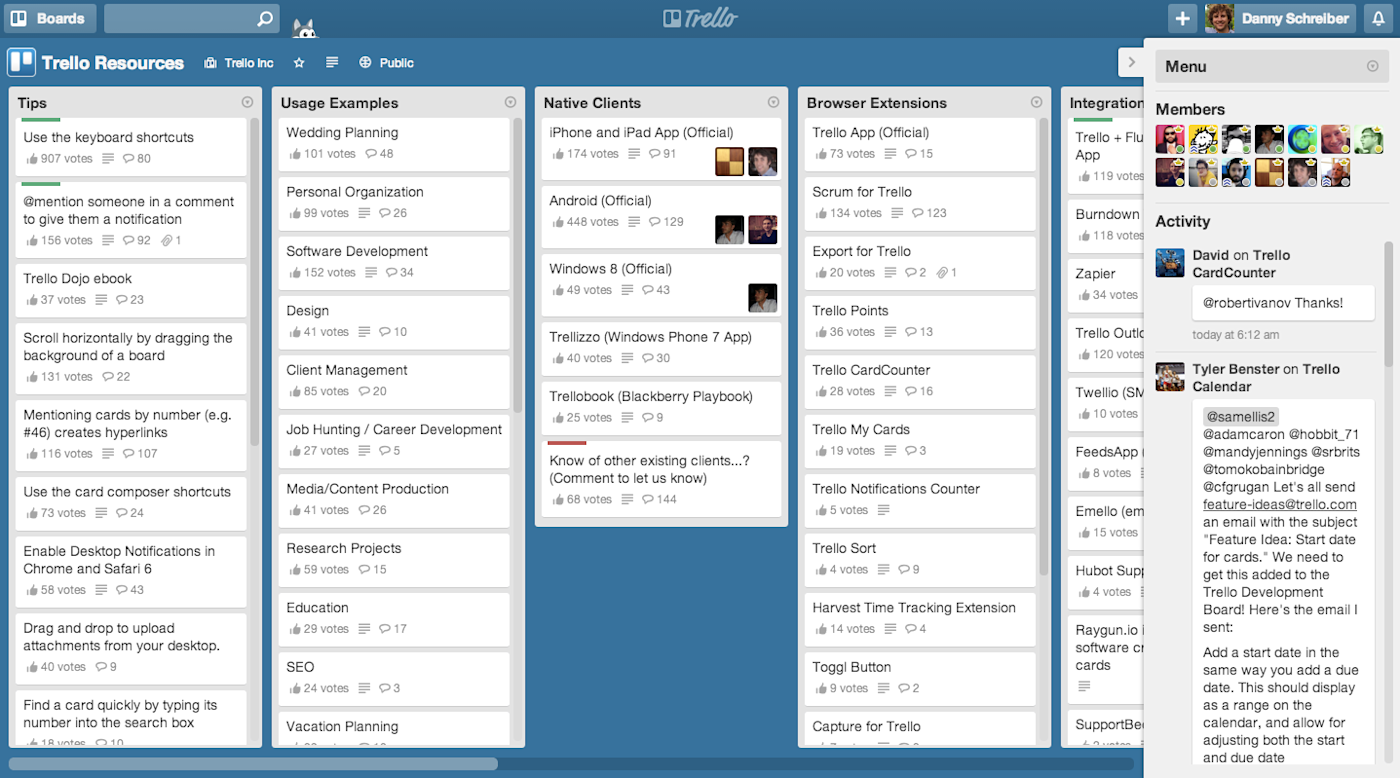
Users are able to contact us by email through our support site at trello.desk.com with questions as well as through social media and from within our iOS and Android apps via Trello boards that are setup for each app.
I prefer email because it is the easiest way to get to the heart of the matter. Screenshots can easily be attached to the email to provide a clearer picture of any issues, and I can feel secure that if we need to discuss any account related issues that these emails will be between just the parties involved. Also, since Trello users sign up with their email address, this is the best way to verify account information.
With social media I feel that I can basically only answer the most basic of questions, because more in-depth questions may expose personal and private information, and character length limits (enough said). In most instances, if someone issues a support request via social media I have to ask them to email Trello support because it is usually an account related question Social media does have its benefits, for instance, if we release an update with a major bug, social media will probably sound the alarm first.
Social media does have its benefits, for instance, if we release an update with a major bug, social media will probably sound the alarm first.
Brian Cervino, Trello
One exciting recent support touchpoint has been in-app support for our mobile apps. Now when someone needs Trello support, they do not have to leave the app, but instead are directed to a board within the app that provides answers to common questions as well as ways to comment on a card with any support questions that I can quickly answer. Keeping this kind of support in the app is great because the user is able to easily act upon the answer to their support question without having to go through a bunch of hoops.
Micah Bennett, Zapier
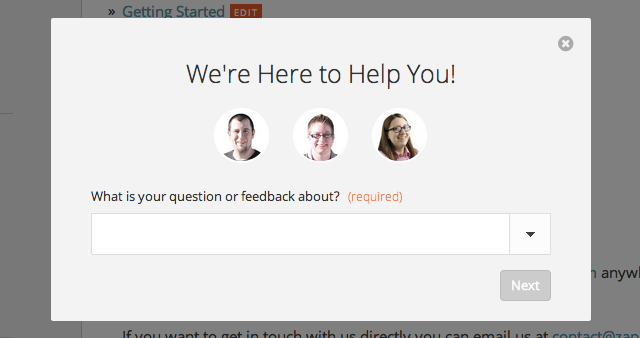
We have a on our help site that lets users get in touch with us and a community where you can get help and inspiration. More generically we can be found on Twitter, and our individual email addresses are available at our about page.
We do have scheduled phone support for users on our highest plans, but we've found that email is both more efficient and faster for most users. Though everyone loves the instant feedback of live support, many times it's a worse experience when the result is getting on the phone with the user, discovering you can't solve that problem immediately, then moving that user to an asynchronous channel where we can get the necessary help to solve the problem. At the same time, we have had live chat in the past and may offer it in some fashion in the future. Live support is more than just troubleshooting, so we can provide value to the user with it as an option when it's done in the right way.
3. What tone do you strive for in talking with users?
Carolyn Kopprasch, Buffer
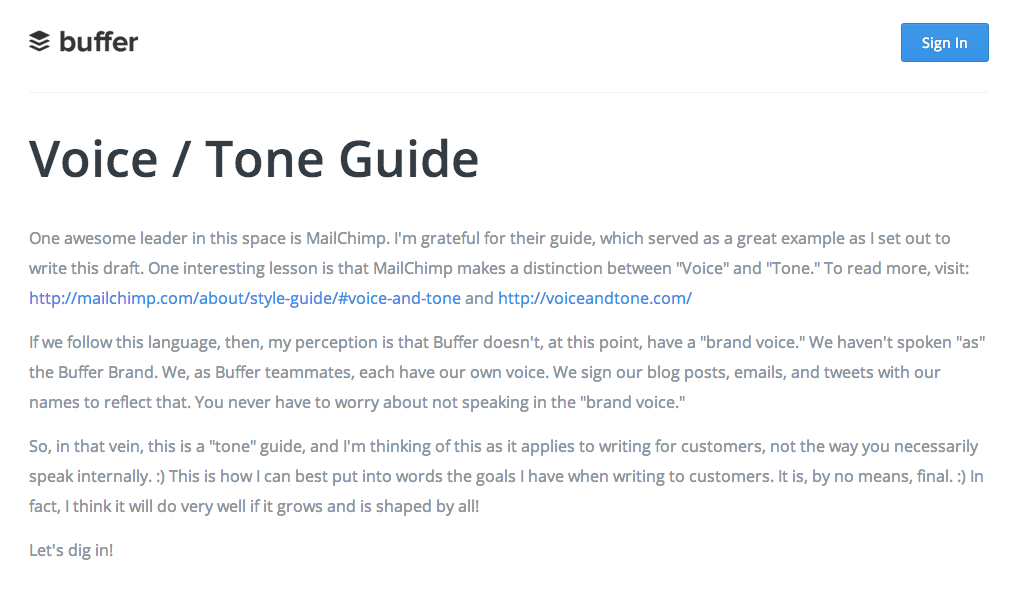
Ah, good one! We have a first draft of a "tone guide", but we mostly just trust our team to speak in the empathetic, thoughtful, gentle way they do. Our Live Chat wizard Patrik and video guy Dave recently coined a concept together that I think sums up our tone really well: we want to focus on the person, not only on the problem to be solved.
Each member of the team has their own "voice", which makes for a super vibrant team of people who all learn from each other daily! So, as far as tone, we want to convey that we are here for our customers, no matter what. This is an aspirational goal, of course! We are always working to get to this. It helps to have blogs like yours to learn from! :)
Grace Antonio, FreshBooks
Tone very much depends on who you are speaking with. Most of our users who call in are just looking for an answer to a questions, very angry customers are few and far between. For the most part, we like to use a friendly, personable, and somewhat casual tone conveying that our No. 1 priority is to help them with whatever they need, no matter how long it takes. We strive to be very empathetic to what their issue is and how it may be affecting their business at that exact moment. When appropriate, asking about their business and what they do always turns into a great conversations. Small business owners are all passionate about their business.
Justin Seymour, Help Scout
I’d like to yield to Help Scout's Head of Content Marketing Greg Ciotti on this one!
Brian Cervino, Trello
I try and strive for a friendly yet professional tone. I can have a very loose and fun demeanor, which can put users at ease, but I want users to know that I am on their side and have their best interests in mind. Empathy is also key. Everyone has been in a situation before where they are at their wits end trying to figure something out and we all know how frustrating it can be. We have all had major deadlines and just as we are about to turn in that document, it can’t be found. These things happen to everyone, and I want to provide a tone that is relaxed, empathetic and that I am there to get everything sorted out.
Micah Bennett, Zapier
We want to get people the information and assistance that they need in a way that communicates that we're actively trying to help, because we are! Our replies need to get them to the appropriate emotional state for that situation, be it celebration when a problem is fixed, commiseration when a user is frustrated, or excitement when we spread the word about new features.
Our replies need to get them to the appropriate emotional state for that situation.
Micah Bennett, Zapier
In some cases that means being more conversational than others, but it always means following the Personality Golden Rule of talking to users like we'd want them to talk to us. That means being friendly, clear, and concise when swapping emails with our users.
4. How do you measure user happiness?
Carolyn Kopprasch, Buffer
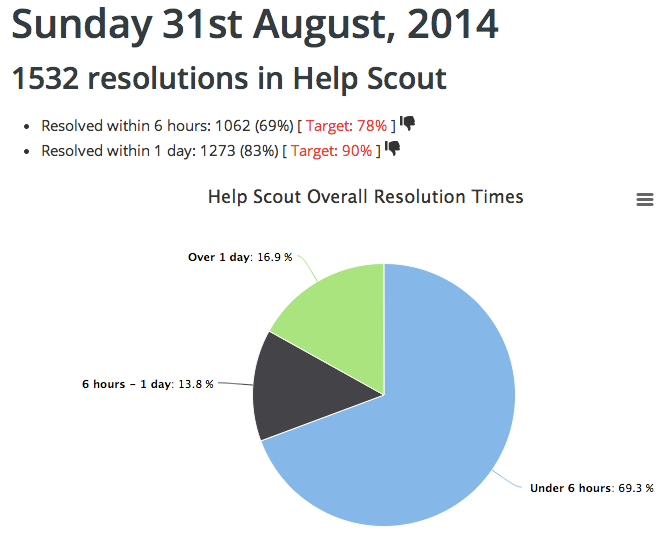
This is such a tough one! I was just chatting with the good people over at Pocket about this one. (Justin and Sim are great people to ask for future versions of this post! :))
We use Hively to measure self-reported happiness at the end of email conversations, as well as a survey after live chats. However, with a response rate of somewhere in the 10% rate, this doesn't cover all experiences.
I'm also reminded of Shervin Talieh's lesson at UserConf Chicago, where he says that you don't need surveys. Your team knows when customers are or aren't happy! So, we also talk about some conversations as a team, even if the customer didn't explicitly say that he/she was unhappy. (Follow Shervin at @calitalieh, and get tickets for UserConf at userconf.co.)
So, where does that leave us in terms of measuring customer happiness?
Overall, we've based our efforts on one main assumption. We made an assumption that faster answers equal happier customers. (Controlling for quality and accuracy of response, of course.) So, instead of focusing too much on trying to get customer happiness numbers, we obsess over getting back to customers and resolving issues faster. We track all of those numbers in our public Happiness Dashboard, in case you'd like to see how we're doing! :)
Grace Antonio, FreshBooks
At FreshBooks, we use Nicereply to send out customer service surveys for any interaction with our Support Team. The current survey just has three faces (sad, meh, happy) and we send them for emails, phone calls and chats. We also run a Net Promoter Score survey for all our paid customers.
Justin Seymour, Help Scout
This one is embarrassing, but we don’t measure user happiness right now. We’re a few weeks off from releasing our satisfaction ratings feature, so we’ll be able to tackle this in a meaningful way very soon!
Brian Cervino, Trello
We do not have any specific metrics or tools to measure user happiness. We keep an eye on social media, app reviews, etc. When it comes to support cases, I measure user happiness by following a case until its resolution and getting the confirmation from the user that we have met there expectations, and if we haven’t, I at least make sure there is an understanding in place as to why we haven’t. (We can’t implement every feature request.) Being able to look back at a day’s work in the support queue and close out all of the cases that end with a kind "thank you" is probably one of the highlights of my job.
Micah Bennett, Zapier

We mentioned Hively in an earlier question, and it's a big help in understanding how users are feeling when we communicate with them. It helps us get a read on if users aren't happy with the product itself or how we're helping them. Users can also give us feedback on our by telling us if a specific doc is useful or not. This gives us direction on spots where we need to tighten up wording, or add details or screenshots. We also use support volume itself along with some other internal measurement to help find problem areas of the app where we can improve UX, add documentation, or add functionality to give our users what they need.
5. What three traits do you look for in a support hire?
Carolyn Kopprasch, Buffer
Just three?! :) Well, let's see. Happiness Heroes at Buffer try to bring joy and relieve stress of all those around them, not just when they're at work. So, that's first.
Secondly, they have really fantastic writing skills. That means not only writing clearly, and simply, but with empathy and feeling. I love reading their writing, not just to our customers but to each other and the other members of the Buffer team.
Lastly, I think being "startupy" helps. I guess another way to say that is "entrepreneurial" but "startupy" is so much more fun. That is, they get a lot thrown at them. They often stay up late, make tough decisions, and answer tweets from trains. These folks roll with whatever questions, challenges, or opportunities are thrown their way. Dave recently visited Paris to host a Buffer meetup. Åsa traveled Europe and worked from cars, trains, and airports. Octavio stays up late to answer any overnight questions while we look for our next team member in that time zone. These folks put their customers first, and it shows. :)
Get in touch with us anytime at hello@bufferapp.com or on Twitter at @Buffer! :)
Grace Antonio, FreshBooks
The three main traits FreshBooks looks for in a support hire, in order of importance, are:
A genuine want to help people—emphasis on the "genuine". Many people want to work at FreshBooks because it looks like a fun place to work and they are excited about the culture, but fail to show that they actually want to work in this role. We’ve done enough interviews now to distinguish when candidates are just saying what they think we want to hear versus how they really view customer service.
Fit within our Support culture. We have a very tight-knit team and feel this is one of the main reasons that our team is so happy. Adding a new hire that may rock it on the phones, but does not fit in with our culture would not make it through the interview process. Our Support team has the lowest churn in the company, something that we are very proud of, especially considering it’s a customer service role.
Technical skills. FreshBooks is a software company and new hires will be providing tech support on the web and mobile devices, so it’s imperative they have at least a minimum amount of knowledge about troubleshooting internet things. The questions we have are not terribly hard, but will definitely expose those that don’t know what clearing a cache means.
Justin Seymour, Help Scout
Aside from some of the common and desirable traits, such as being an incredible communicator with a thick skin, a sense of humor, and a knack for solving problems, there are a few key things we're after:
Hustle - I'm not talking about fortune cookie hustle, where all of your 60-hour weeks pay off, nor am I referring to the speed at which an applicant answers tickets. I'm talking about good ol’ fashion work ethic, day in and day out. The kind of hustle your grandpappy had back in the day, when he did nothing but stack hay bales and toss bags of grain around on the farm.
You want someone you can trust to do the work, and do a damn good job without much (if any) oversight. This is especially key if you're a small or medium sized team with remote employees.
There's no shortage of discussions on how to measure productivity on the support front, but if you ask me, you shouldn't need to obsess over productivity if you're hiring the right people. There is no substitution for hard, honest work.
Passion - Skills can be coached, habits can be changed, attitudes can be adjusted. You can't make someone enjoy other human beings, nor can you teach or coach "care". Hire the passionate people person who talks to strangers on a whim, and the rest is easy.
That’s a no brainer, right? Maybe, but judging a candidate's level-of-care is not an easy thing to do. If you get it wrong, you're setting yourself (and the customer) up for failure.
If the applicant doesn't really care about your team, your product, and the good people who use it, you don't need a psychic to tell you what's to come. Your core team is quite literally the foundation on which you're going to build your company, so pick good cinder blocks.
If Help Scout was a living entity with a pulse and pair of lungs, there isn't one person on our team who wouldn't take a bullet for (it) the product. I hope you feel the same way about the people you work with.
Hardiness - It's hard to find someone who will openly settle down into a support role for the long haul. The job can be dull and frustrating; burnout is high. Potential candidates will sheepishly say exactly what you want to hear: I love support, and I don't have a problem doing the same thing day after day. Oh, stop. You’re not fooling anyone.
Always hire the honest guy or gal; the one who can say with all humility, that support can suck. We tend to sugarcoat the process of providing support, because that's what people see on the outside. Everything is awesome, all the time! When you're interviewing, though, it's good to talk about the frustrating stuff that no one is writing about:
How do you deal with angry customers? (Hint: The answer does not involve a tidal wave of apologies.)
What if someone insults your mother on the phone? (Hint: Go with it.)
How do you cope with monotony? (Hint: You don't; get up and take a break. )
In most cases, the support department (what a terrible name) has a revolving door: one college graduate comes in, another goes out. And don't forget about those go-getters who join the support team just as a stepping stone. Do they really care about the product? Are they capable of truly caring about the people who use the product? Of course not.
Always hire the honest guy or gal; the one who can say with all humility, that support can suck.
Justin Seymour, Help Scout
Hardiness, or the willingness to endure, alongside a quiet resolve are incredibly rare but essential traits when hiring for longevity.
Brian Cervino, Trello
The three traits that I would most look for in a support hire are empathy, passion, and communication skills.
Empathy for the user, because they are frustrated and we are the one that they are reaching out for, no matter how big or small, how obvious or obscure the question is.
Passion for the product that they are supporting, because they need to understand and use the product with as much joy and depth as our users or they will never truly empathize with the user.
Communication skills because not only are they going to be helping individuals from all technological backgrounds, but they will also be the link between our users and our developers. Being able to take what users say, whether it is about software bugs, use case scenarios, or suggestions and present that to the team in a clear and concise manner is the only way that the users voice will be heard and considered by those that are making the decisions for the future of our product.
Micah Bennett, Zapier
It's difficult to narrow down to three, but if we're forced to choose:
"App Curiosity" - At Zapier we constantly work with hundreds of different web apps, so an interest and proficiency with them is crucial. Having that sixth sense for both how to get apps to do what you want and the familiarity from hours spent playing with such apps is a huge help in troubleshooting.
Positive attitude - Having a happy and positive outlook manifests itself in a couple ways and has several benefits. From being truly invested in helping users to being able to not carry over negative vibes from one user to the next, a strong candidate can be relentlessly positive.
Clear and concise writing - At Zapier, support is a lot of writing, and as such we need to be great at communicating with our words. Word choices are crucial in advising what users need to do, and also in a way that doesn't confuse them or waste their time. This is even more important in a remote team like Zapier is, because those words are the primary form of communication within our team as well.
Roundtable II Reflection
My favorite part of reading through all of these responses is seeing the themes that permeate the answers to a particular question or the tone that is set with one person's answers to all the questions. The similarities and differences are a great reminder, too, of both the need for guiding tenets to provide quality support, but also the understanding that businesses can vary and there is no one-size-fits-all solution.
You might also enjoy this post: "Start Preventing Fires: How to Implement Proactive Customer Support"
Credits: Carolyn Kopprasch photo from About.me. Grace Antonio photo from LinkedIn. Justin Seymour photo from Help Scout. Brian Cervino photo from LinkedIn. Micah Bennett photo courtesy Zapier.





